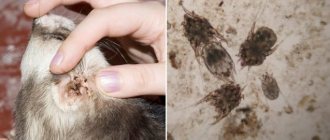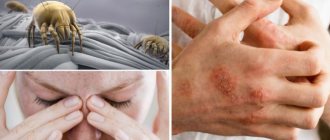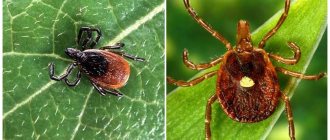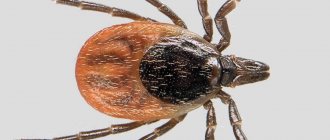Ear mites in kittens and adult cats are not so rare. In the absence of timely, qualified treatment, a pet can not only lose hearing, but also die. That's why it's important to keep an eye on your animal: if your cat is shaking its head and scratching its ears, it's time to check it for ticks.
Features of the disease
Otodecosis in cats is caused by the microscopic (about ½ mm) insect Otodectes cynotus.
The parasite has a whitish oval body and jointed limbs. It loves moisture and warmth, so it parasitizes inside the animal’s ear canal, feeding on skin scales, blood, and lymph. Outside the host's body, the tick can live for about two months. In most cases, the parasite affects both ears of the cat. The likelihood of infection is especially high during the warm and humid seasons - spring and early autumn. The risk group includes kittens under one year old and weakened animals. It may take several years from the moment of infection to obvious signs of the presence of a tick. The disease manifests itself especially clearly when a bacterial infection is added to the skin damage by the parasite. Due to itching and pain, an exhausted pet cannot sleep or eat.
Briefly about the pathogen
Otodectes cynotis, the causative agent of the disease, is so small that it is difficult to see with the naked eye. Its body dimensions are approximately 0.2-0.5 mm. However, if you examine with a magnifying glass what an ear mite looks like, you can see slowly moving pale yellow, white dots. The parasite feeds on skin scales from the ear canal of animals. Lives on the surface and does not dig.
The life of a tick lasts 3 weeks:
- Females lay eggs and attach them to the skin with a viscous substance and cement them. Each female lays 5 eggs per day.
- After 4 days the larvae appear. Within 3-10 days they begin to actively feed. Then comes the rest phase (from 10 to 30 hours).
- The cycle changes and the larvae move into different stages of development (protonymph and deutonymph).
- While in the deutonymph stage, the larvae attach themselves to the males. And if the deutonymph is a future female, then when she becomes an adult, she already turns out to be a carrier of eggs.
An adult lives on average 2 months. Life outside the animal lasts approximately 12 days.
The danger of ear mites for cats
Ear mites feed on skin particles, causing severe damage to the skin. If left untreated, your cat may develop serious health problems:
- unbearable itching causes constant scratching of the ears, which leads to damage to the capillaries and the appearance of extensive hematomas;
- Bacterial and fungal infections penetrate into places where the skin is damaged, the inflammatory process begins, the ear tissues swell, redden, and fester;
- gradually the inflammation spreads to the eardrum and to the inner ear - otitis media and myringitis develop.
Further delay with therapy will lead to weakening and then loss of hearing. Pain and itching interfere with normal rest and eating. The animal becomes irritated, nervous, and aggressive. Over time, inflammation can penetrate the membranes of the brain, resulting in death.
How do you get infected with otodectosis?
Ear mites in cats can appear if the animal has been walking outside and has been in contact with other cats. Most homeless animals suffer from otodectosis. If you let your pet outside, you should carefully examine it after a walk and do not neglect the rules of hygiene.
There is a possibility of introducing ticks on shoes or clothes. The owner can pet an infected feline or simply walk past a pack of stray animals - and this will be enough for the parasite to travel to a completely domestic cat.
There is a high risk of the disease appearing in those homes where similar cases have already occurred. Ear mites in a kitten are transmitted from the mother, as well as through carpets, various products, home furniture - everything that can accumulate dust particles and microorganisms.
Routes of transmission of ticks from one individual to another
The most common variant of infection is contact with already sick animals. It is enough for one cat to sniff another for several parasites to leave the host and be transmitted to a healthy animal. But there are also indirect methods of infection.
Cat ear mites live up to two months in their natural environment, which means they can be picked up through indirect contact. The disease is transmitted through care products: scratchers, carriers, bedding. Sometimes the infection is carried by fleas or flies.
If a room is not regularly cleaned, the mite settles there, waiting for a host. This should be taken into account when moving or when leaving a cat as a guest for a while.
At elevated temperatures the parasite lives even longer. It stays on clothing and shoes. Therefore, it is important to protect your cats from contact with outdoor shoes and outerwear - ideally, there should be a closed closet in the apartment.
To summarize, we can say that the main “helper” of otodectosis infection is unsanitary conditions. A domestic cat that is carefully cared for, vaccinated and kept clean has the least chance of getting sick.
Progression of the disease in stages
Otodectosis is the most popular skin disease. Ear mites in cats are diagnosed in 85% of cases when breeders treat suspected otitis media. The carpet beetle corrodes the upper surfaces of the epidermis, located on the inside of the shell. The disease proceeds as follows:
- Mechanical injury. At this point, the upper layers of the dermis are damaged. With its powerful mouthparts, the parasite chews the surface, obtaining blood and lymph. The nerve endings become irritated, resulting in severe itching.
- Blood vessels begin to thin out. They become filled with blood, redness and swelling appear.
- You may notice persistent discharge in areas of damaged skin.
- Dark brown scabs form from dead skin cells, as well as other waste products of pests. The whole process is accompanied by the formation of putrefactive microflora.
- There is a gradual accumulation of scabs and crusts, which leads to the formation of a plug. Hearing begins to become dull. If measures are not taken, the eardrum will rupture. The infection opens up to the middle and inner ear.
If parasitosis is advanced, then an active inflammatory process develops in the inner and middle ear. The symptom is a certain behavior of the animal: the sick person walks with his head turned 90 or even 120 degrees. The ear that hurts will point downwards. This process leads to the spread of pathology to the membranes of the brain, sepsis and, as a result, death.
Breeders need to remember that such a simple disease can result in disastrous consequences. But even in advanced cases, it is possible to successfully treat ear mites in a cat and avoid serious consequences.
How can a pet become infected?
A cat can pick up ear mites on the street, through contact with sick animals or in walking areas. Most stray cats suffer from otodecosis, so letting your pet roam freely is fraught with negative consequences.
The parasite can be picked up on shoes by the owner while accidentally walking in places where stray cats like to gather. An owner can bring ear mites home after petting someone else's pet with otodecosis. In addition, there is a high probability of disease in homes where there have already been (or are) cases of the disease in other animals.
Kittens can become infected at birth from a mother who is a carrier of ear mites. Infection through bedding, carpets, household furniture or dishes is possible.
Danger to humans and other animals
Many owners fear that ear mites are dangerous to humans. However, otodectosis is not transmitted to people or even small children. But for other pets the disease is dangerous, as it is easily and quickly transmitted.
It is worth remembering that a person can become a carrier of parasites without getting sick. Therefore, it is easier to keep the house clean and care for your pet than to treat it later.
Symptoms of ear mites in cats
There are practically no symptoms of ear mites in cats at the onset of the disease. You should take your pet to a veterinarian if the following signs of illness are detected:
- frequent scratching of the ears, leading to bruising;
- head shaking, restlessness;
- discharge from the ear canal of liquid, stuck together pieces of sulfur of a dirty gray or dirty brown color;
- glued fur on the ears;
- hair loss in the ear area;
- purulent ulcers on the outer ear;
- swelling and redness of the ears;
- unpleasant odor;
- the animal walks with its head bowed.
You should suspect odecosis if your cat periodically shakes its head and scratches its ears. Discharge, odor and other signs appear later, when the disease takes an advanced form.
Mr. Cat explains: are ticks dangerous for humans?
Human infection with otodectosis occurs in extremely rare cases. Infection with a tick leads to the development of external otitis.
You can become infected with the disease if there is damage to the epithelium of the outer ear, a pronounced decrease in immunity, or through close, prolonged contact with an infected animal. Therefore, veterinarians recommend taking safety measures when identifying otodectosis in a pet.
We also recommend reading the article about how a person can get infected from a cat.
Diagnosis of otodecosis
Even if there are seemingly obvious signs of ear mites, the cat should be shown to a veterinarian. Similar symptoms may appear with dermatoses, lichen, fungal and bacterial infections. In addition, there is another type of external microscopic parasite that lives on the ears of cats. Therefore, before starting treatment, a diagnosis is required.
The diagnosis is made based on examination and microscopic examination of scrapings from the surface of the auricle. Under a microscope, the doctor will quickly identify the parasite and prescribe appropriate treatment.
If laboratory diagnostics are not possible, you can try the home method. To do this you will need a black sheet of paper and a magnifying glass. You need to take a little discharge from the inner surface of your pet’s ear and smear it on paper. If there is a parasite, then on the leaf it looks like a moving whitish dot.
Medicines for ticks
Medicines for ear mites are available in the form of ointments or drops. Among the large assortment, it is difficult to choose the right remedy on your own: you should take into account the degree of damage, the presence of concomitant infections, and the age of the animal. In the treatment of otodecosis, the medications listed below are most often used.
A drug
Course of treatment, dosage
Note
Amidel
The gel is applied to the cleaned surface of the ear 3-5 times at intervals of one week.
Do not use on kittens under 2 months of age or on cats during pregnancy.
Otoferonol Gold
Apply twice with a break a week. Dosage – 3 drops in each ear.
Do not use on kittens under two months of age or pregnant cats. The product destroys the parasite and has an anti-inflammatory effect.
Aversectin ointment
Apply 2-4 times, interval – 7 days.
Do not apply the ointment to kittens under 2 months of age or during pregnancy.
Amitrazine
The course of treatment includes 4-5 procedures. The breaks between instillations are three days. Dosage – ½ ml in one ear.
Not for use in pregnant cats.
Dekta
Ear drops are used every five days, 4-5 drops once. A total of 2-4 procedures are required.
The product is not suitable for babies under 30 days old and pregnant cats. The composition includes an antibacterial component.
In difficult situations, the veterinarian will prescribe injections or antibacterial drugs.
How to treat the ears
You need to treat the ears of your furry pet as follows.
- Before using the medicine, the cat's ears are cleaned of accumulated plaque. This will allow the medicine to penetrate deeper. For cleansing, use special solutions or regular vegetable oil. The surface of the ear is wiped with a cotton pad or a piece of bandage soaked in the solution. Hydrogen peroxide or other agents should not be instilled into the ear canal!
- Apply ointment or drops to the clean surface of the auricle in the amount specified in the instructions for the drug.
- To ensure that the medicine is distributed evenly, the ear needs to be massaged a little.
- If drops are used, the cat's head should be supported to prevent shaking and the medicine being thrown out.
- In conclusion, it is recommended to wipe the auricle again with a cotton pad soaked in the same product.
Attention: it is not recommended to use cotton swabs to treat the ears of an animal - the likelihood of injury to the ear canal and infection in the deep parts of the ear increases.
How to properly clean a cat's ears
To remove ticks, you need to know how to properly clean your cat's ears.
- To carry out this procedure, use a cotton pad that is soaked in lotion.
- After which they are carefully passed along the visible surface of the auditory canal.
- Next, the ear is pinched and massaged for several seconds.
- Then you need to clean the surface of the sink with a clean cotton pad.
Such manipulations are carried out several times until the inner surface is completely cleared of sulfur secretions and waste products of pests. Next, you can begin applying medications.
On a note!
To prevent the development of the disease, experts recommend cleaning both ears, regardless of which one is infected with mites.
Concomitant therapy
When treating ear mites, you need to keep in mind that the parasite can spread to the cat’s body, so in parallel with treating the ears, antiparasitic procedures for the whole body should be carried out. To do this, just apply a few drops of a special preparation to the pet’s scruff or treat it with a spray. Among the sprays, the most popular are Frontline and Cyodrin. It is imperative to ensure that the animal does not lick its fur for a certain period of time.
You should also take care of your furry pet’s immune system. The stronger the immune system, the faster the recovery, and the greater the chance of avoiding re-infection. A cat's diet should contain a large amount of vitamins and be varied. You can add ready-made vitamin complexes to the food. It is also recommended to carry out a course of therapy with drugs that enhance the body’s defenses - Gamavit, Tentravit.
Prevention
The appearance of ticks is a case more typical for “walking” animals. However, even if your pet has never left the walls of the house, this does not guarantee that you will not encounter the disease. The reason may be the use of other people's carriers, bedding or toys.
Preventive measures include:
- regular ear cleaning (Bars Lotion, Otifri, Otodepin are excellent);
- preventing contact with stray animals;
- periodic disinfection of paraphernalia (beds, bowls, etc.);
- strengthening the immune system (it is recommended to include foods high in microelements and vitamins);
- the use of special drugs during the period of parasite activity.
Give your furry friends more attention, which is expressed not only in affection and feeding. Do not forget that they, like any living organism, require care. After all, when the animal receives it at the proper level and is in a calm state, then the owner is happy. Good luck!
Treatment with folk remedies
Treatment with folk remedies is permissible only at the very beginning of the development of the disease. In case of obvious symptoms of ear mites, they are suitable only as auxiliary methods. In addition, folk recipes can be used to prevent odecosis.
One of the most common cat ear care products is green tea. Its strong infusion acts as an antiseptic. After the brew has cooled, soak a cotton pad in it and wipe the external auditory canal. The decoction can be used both to cleanse the ears before instilling drops, and for regular care.
Hydrogen peroxide is used in the same way. It cannot be instilled into the ears; it is only allowed to moisten the crusts and wipe the surface of the cartilage.
Vegetable oils are widely used to clean the ears. Any oil will do: olive, sunflower, vaseline, camphor-based. Oils are not suitable for preventing the disease, but they can soften and remove scabs. After applying the oil, the animal’s ears should be wiped with a clean disk so that the oil film does not interfere with the absorption of the medicine.
Sometimes it is recommended to use garlic pulp or juice to combat ear mites in cats, but its irritant properties in this case will be stronger than its antiseptic properties. In addition, garlic will still not be able to destroy the parasite, so this remedy should be abandoned.
Areaty alopecia
There are many causes of hair loss - from poisoning to local or systemic infections. However, unfortunately, sometimes we don't know exactly why hair actually falls out. One of these diseases is alopecia areata, or alopecia areata.
What it is?
This is a chronic disease that affects the hair follicles and sometimes the nails. It appears in the form of rounded areas of non-scarring hair loss on the head, sometimes on the face (eyebrows, mustache, beard), as well as other areas of the skin.
What is the reason?
The reason is still unknown. There are theories of autoimmune damage to hair follicles, genetic determination of the disease and many others, but in fact we do not know why this appears and why it goes away.
What does it look like?
One fine day (or night) on the head (very rarely, primarily on other areas of the hairy skin), a lesion with fallen hair is discovered. As a rule, it does not hurt, does not itch, and sometimes there may be a slight burning sensation, which many patients at first (before the defect is discovered) do not attach importance to. Also (if “caught” at the initial stage) some patients may have slight redness of the skin. The skin on long-term lesions does not differ from normal skin.
Areas of hair loss are usually round, and there may be easily (with the slightest twitch) hair falling out and hair fragments along their edges. In severe forms of the disease, nails may be affected: dull color, thimble-shaped indentations, longitudinal striations, free edge in the form of wavy jagged edges.
How does it vary in severity?
There are local, subtotal, ophiasis, total and universal clinical forms.
- In the local form, one or more clearly defined round foci of alopecia are determined on the scalp.
- With the subtotal form, more than 30–40% of hair is missing from the scalp.
- With ophiasis, foci of alopecia cover the entire marginal zone of hair growth on the head, or the frontotemporal region, or only the back of the head.
- With the total form, there is a complete absence of hair on the scalp.
- With the universal form, there is no hair on the scalp, eyebrows, or eyelashes; on the body, vellus hair is partially or completely lost.
Alas, all forms of the disease can transform into one another.
Who to treat?
It is better to see a dermatovenerologist specializing in trichology. You cannot self-medicate; most treatment methods have significant side effects, and are even simply dangerous for general health.
How to diagnose?
Usually the diagnosis is not difficult. Typically, general tests, tests for fungi, and tests to rule out syphilis and common autoimmune diseases are performed.
Perhaps, to determine treatment tactics, a trichogram may be needed - a study of the hair roots along the edges of the lesion.
How dangerous is this? Currently, there is no convincing evidence of the connection between alopecia areata and any other specific diseases and/or pathologies. Caution should be exercised regarding autoimmune diseases.
What is the treatment?
Like all diseases whose etiology is unknown, and treatment is not always successful, the range of measures taken is quite wide, however, alas, the evidence base for many traditionally used remedies is absent or the evidence of their effectiveness is rather weak.
Glucocorticoid hormones are used systemically and locally (in the form of potent ointments and intradermal injections directly into the skin of the lesion), minoxidil, cytostatics, photochemotherapy (photosensitizers + irradiation are prescribed), local immunosuppressive therapy, tar preparations, various “folk” remedies (onion juice, tincture of capsicum pepper) and many others.
Unfortunately, analysts from the Cochrane Collaboration, comparing reports on the use of certain products, did not find evidence that at least something gives a lasting positive effect on alopecia areata.
What's the prognosis?
Fortunately, approximately 80% of patients with local forms of alopecia areata achieve remission after 12 months from the onset of the disease. Unfortunately, even these people may experience a recurrence of the disease.
For more common forms, the prognosis is significantly worse. In approximately 15–20%, it is not possible to achieve healing of the lesions, and 1–2% of patients experience complete hair loss. Such patients must get used to the idea of a wig or find motivation to be proud of their new look.
In approximately 15–20%, it is not possible to achieve healing of the lesions, and 1–2% of patients experience complete hair loss. Such patients must get used to the idea of a wig or find motivation to be proud of their new look.
The prognosis worsens with early onset of the disease (before puberty); when baldness develops on the head along the boundaries of hair growth (temple area, behind the ears, lower third of the occipital region); with pronounced changes in the nail plates; the presence of concomitant autoimmune and atopic diseases in patients.
Since we do not know what causes alopecia areata, there are no special measures to prevent the disease/recurrences.
Since the problem is cosmetic in nature and associated with social adaptation, most patients at one stage or another of the disease need the help of a psychologist or psychotherapist.
Good health!
Leonid Shchebotansky
Photo istockphoto.com
Products by topic: (Alerana), [product strict=”generolon”](generolon)
Main rules of treatment
When treating odecosis at home, you need to follow a number of recommendations.
- If there are several animals in the house, all of them need to be treated for ticks, regardless of the presence or absence of the parasite. It is better for kittens and cats to use spray products during pregnancy.
- Be sure to treat your pet's bedding with an antiparasitic agent. If possible, it should be boiled.
- Until the product applied to the withers has dried, it is important to monitor the cat, preventing it from licking itself.
- Since recovery depends on the state of the immune system, it is necessary to provide your pet with a balanced diet and include vitamin complexes in it. Periodically take the animal out into the fresh air.
- Ear mites can also live on furniture, carpets, floor cracks and other objects, so wet cleaning should be done by adding an acaricidal agent to the water.
- Do not use ethyl alcohol-based products to clean your cat's ears.
Are there strong remedies for ear mites?
There is a stronger way to get rid of ear mites than ointments and drops. These are injections. Their distinctive feature is that you can get rid of all parasitic insects at the same time (if they are present). At the same time, the use of this method is fraught with negative consequences - the active substances are toxic to the cat’s body. Their use can provoke allergies, baldness, dermatoses and other complications. The use of such drugs is contraindicated during pregnancy and for kittens.
How to prevent otodecosis
In most cases, tick damage to a cat's ears can be prevented. To do this, you should adhere to the following preventive measures:
- periodically inspect your pet’s ears for scratching, redness, swelling, and scabs;
- regularly clean the external auditory canal;
- do not allow communication with unfamiliar animals;
- strengthen the cat's immune system.
Paying close attention to your pet and promptly seeing a doctor will help avoid health problems.











